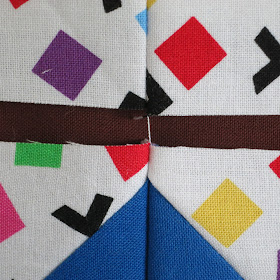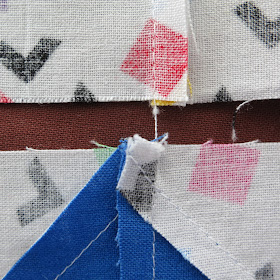In classes, I teach a step about how to put together sewn blocks. Initially, this was called "making a spiderweb" because that's what it looks like. Landauer suggested spiderweb wasn't such a pretty word, so it was shortened to "web." For the book, I sewed samples and we photographed the web-making process. Then, editors decided not to include it in the book because it was too difficult to see!
So after being asked several times for a tutorial on this (thanks Des Moines MQGer's), that's what you're getting.
In a nutshell, making a Web is a process for:
- keeping blocks organized just the way you laid them out;
- and, economizing on time and thread to put together a quilt top.
For this tutorial, I prepared 6-1/2" X 6-1/2" (unfinished) blocks to make a 36" X 48" baby quilt for Project Linus.
Terminology
Eight blocks running vertically are in columns - column A; column B; column C; and so on.
Six blocks running horizontally are in rows - row 1; row 2; row 3; and so on.
Remember this by thinking of an electronic spreadsheet with alphabetical columns and numbered rows.
Marking
Until you get the hang of columns and rows, it's helpful to use flat-head flower head pins, or sticky notes to remind you of positions.
You don't need to do both. Just mark according to your preference.
Sew a Web
Place blocks in column B, right sides together, on blocks in column A, as shown in this photo.
Row 1 column B block is right sides together on row 1 column A block; row 2 column B block is right sides together on row 2 column B block, and so on.
After putting block pairs together, pick up pairs keeping row 1 on top, followed by row 2, row 3, and so on. If you've used a pin at the top of the block, this will be a reminder that, "I'm the first pair of blocks." Otherwise, you can pin your sticky note to the top block.
Take the stack to your sewing machine, keeping the pin on top. Sew together A-B from row 1.
Without cutting threads, feed A-B row 2 under the needle. This is called chain-piecing, or chaining.
This is what the thread looks like between blocks.
Continue chaining together all A-B blocks through the last row. For my quilt, this was eight pairs of A-B blocks.
Here, the A-B pairs are sewn and back on the design wall, ready for the next step. Only the chaining thread between each row is keeping them together.
The next step follows, but please read ahead before continuing.
Place column C blocks - right sides together - onto column B blocks.
Here, each row of column C blocks are, right sides together, on top of column B blocks.
At this point, you are probably noticing that this will be awkward to take to the sewing machine. It's necessary to explain it this way so you can understand why it's better to do the follow:
Simply pick up and make a stack of every row of column C. Keep row 1 on top, followed by row 2, row 3 and so on. Take the column C stack to the sewing machine.
As when sewing together columns A-B, join column C to column B. Chain-piece together each row of column B-C blocks.
I bet you have this figured out now, so it won't be a surprise to know that you'll continue putting your top together by stacking column D and sewing it to column C; stacking column E and sewing it to column D, and so on.
And if you've got it down pat, you can stack and line-up all the columns. No hopping up and down from the machine to the design wall and back again.
When you've sewn together all the columns you've got a Web! Yay for you!
I pinned my Web to the design wall so you could see what it looks like. Every block is where it's supposed to be, with columns joined to one another and "Webs" connecting each row.
 |
| A big picture, to see those connecting chain threads. |
The first time pressing is needed is now. With the back facing up, press seam allowances one direction in each row. It doesn't matter which direction you press, only that each row alternates direction.
Here's a close-up of seam allowances going opposite directions, and chaining separating rows.
This step can be done at your sewing machine, but for purposes of explanation, I put my Webbed quilt on the design wall.
With the quilt facing up, lay row 1 on top of row 2, right sides together.
If you're a person who likes to pin, feel free to do so.
When pinning at seam allowance intersections, do not pin through the seam. Doing so only pushes apart the accurate intersection we're aiming for. Instead, butt together the seam allowances and pin on both sides of it.
This is what you're striving for. A tight joining - also called "nesting" - with seam allowances aiming opposite directions.
Sew to join row 1 to row 2, backstitching at the beginning and end of the row.
Still with the quilt facing up, place row 2, right sides together, on top of row 3. Pin if desired. Sew to join row 2 to row 3, backstitching at the beginning and end.
Another nested and pinned intersection.
Continue in this manner, sewing row 3 to row 4, row 4 to row 5, and so on, to complete your quilt top!
Final Pressing
Press row seam allowances one direction. Whether you choose to press them up or down doesn't matter.My completed quilt top didn't take long to sew together, and more importantly, none of the blocks got turned the wrong direction.
 |
| 36-1/2" X 48-1/2" |































Wonderful tutorial; so clear and easy to understand. I will make one of these baby quilts for sure - I really love the process. Thanks so much for sharing.
ReplyDeletePS: What is the book called you wrote or co-wrote?
The book is "First Time Quiltmaking." It's been sold in Joann Fabric stores, but I haven't seen it in the local store for some time.
ReplyDeleteExcellent tutorial! I do make mine this way!
ReplyDeleteGreat tutorial. This is pretty much the way I do mine too. I love the zigzag blocks for a baby quilt - they make up so quickly!
ReplyDeleteCool! I know I've heard of people doing this, but I haven't tried it yet. You make it so clear and simple. :) I'll be trying this out very soon - hopefully this week! - on a baby quilt!
ReplyDeleteThanks for the tutorial Linda! (and so glad to see my computer letting me leave comments on your blog again)
ReplyDeleteAlmost the exact same way I do mine - this tutorial will help so many people!! Great job.
ReplyDeleteI've been sewing my tops together like this ever since I took Stichin' Mission! Great tutorial!
ReplyDeleteWhen I work in blocks, I sure use this technic, it is great and I have learned it while I was visiting you in Des Moines!
ReplyDeleteThis is how I do it, too. Thank you for posting the detailed explanation, as I can point a friend at your post. My attempt at a verbal explanation was very inadequate.
ReplyDeleteA great tutorial Linda. I use chain piecing most of the time but have not gone quite this far by doing the entire quilt. Very nicely explained.
ReplyDeleteLovely, clear explanation of a technique I'd heard of but never seen. Love the zig-zag quilt.
ReplyDeleteCongratulations on a great tute, Linda! I've never done an entire quilt with chaining like this...I'll try it on the next one!
ReplyDeleteI love this method - it's so great for keeping blocks in order… It's saved me from losing my marbles more than a few times! You've done a great job of explaining it clearly and concisely.
ReplyDeleteThis was great. I'm bookmarking this for all the newbies in my sewing group. So clear and understandable!
ReplyDeleteElizabeth E.
thanks so much for this easy to understand tutorial ! I do chain piecing but usually in rows and then cut the pieces apart when I'm finished so I need to number each square - this way of doing it will be way easier and I have a little quilt on my design wall that I'm going to try it on this week :)
ReplyDeletegoing to put this to use right now! Thanks for very clear instructions :)
ReplyDeleteClear instructions and great visuals, Linda. I'm about to lay out the blocks for the Central Florida,Modern Quilt Guild donation quilt. This will be very helpful to sew these 132 blocks together. Thanks for your time and effort in putting this tutorial together for the benefit of others!
ReplyDeleteThis is a excellent tutorial! I find it better than the tutorials on YouTube! Thank you for taking the time to share! I will defiantly incorporate this into my next baby quilt and then work my way up from there:)
ReplyDeleteLinda, thanks so much for the tute! I got so tired of sewing 1.5" squares together, piece by piece. My daughter said to google webbed piecing method, and yours came up! Win, win! I hope you are well! Take care, my friend!
ReplyDeleteI just stumbled across your tutorial and just used it on a large HST quilt. Thanks for the in-depth instructions!
ReplyDeleteThank YOU, Cindy, for taking the time to comment. I'd reply to you directly, but you're a "no-reply commenter" so I have no email address to respond to. I'm glad you found my tutorial helpful!
DeleteI love this idea! Keeps all the pieces in the right place close at hand. I will definitely be trying this! Thanks, Linda
ReplyDeleteHi Sandy! Glad to know you like this. Thank you! Hope it works out. (Wanted to reply to you privately, but you’re a “no-reply commenter.” Sure hope you read this!)
Delete